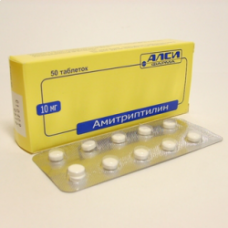Expiration date: 02/2026
Composition and form of issue:
1 tablet contains amitriptyline (in the form of hydrochloride) 10 or 25 mg in a blister of 10 PCs., in a cardboard pack of 5 blisters.
Pharmacological action:
Inhibits the reuptake of catecholamines (noradrenaline, dopamine, serotonin) in the Central nervous system, blocks muscarinic cholinergic receptors in the Central and peripheral, has other anti-mediator properties (including H1-antihistamines).
Pharmacokinetics:
When ingestion bioavailability is 33-62%, Cmax in plasma is reached after 4-8 h. it is Metabolized in the liver to form the active metabolite although. Therapeutic blood levels for amitriptyline and although — 120-240 ng/ml. Excretion is mainly renal. Complete excretion occurs within 7 days. T1/2 amitriptyline 10-28 h, nortriptyline 16-80 h. Amitriptyline passes through the placental barrier, penetrates into breast milk, creating concentrations similar to plasma.
Indications:
Depression (especially effective in anxiety and depression), mixed emotional disorders and behavioral disorders, phobic disorders, children's enuresis (except for children with hypotonic bladder), psychogenic anorexia, bulimic neurosis, severe pain of neurogenic nature, migraine prevention.
Contraindications:
Hypersensitivity, toxic CNS depression, decompensated heart disease, acute and recovery phase of myocardial infarction, violation of conductivity of the heart muscle, hypertension III degree, acute diseases of the liver and kidney, blood diseases, gastric ulcer and duodenal ulcer in the acute stage, glaucoma, prostatic hypertrophy, bladder atony, pyloric stenosis, paralytic bowel obstruction, concomitant use with MAO inhibitors, pregnancy, breast-feeding, child age to 6 years.
Use during pregnancy and breast-feeding:
Contraindicated in pregnancy. Breast-feeding should be stopped for the duration of treatment.
Side effect:
On the part of the nervous system and sensory organs: violation of accommodation, increased intraocular pressure, drowsiness.
On the part of the cardiovascular system and blood (hematopoiesis, hemostasis): tachycardia, arrhythmia, orthostatic hypertension, changes in the blood picture, including agranulocytosis.
From the digestive tract: stomatitis, taste disorder, anorexia, nausea, vomiting, discomfort in the epigastrium, dry mouth, delayed stool, bowel obstruction, impaired liver function (rarely).
Other: skin rash, hair loss, enlarged lymph nodes, fever, gynecomastia, galactorrhea, changes in ADH secretion, decreased libido, potency, weight gain with prolonged use, urinary retention.
Drug interaction:
Neuroleptics, sedatives and sleeping pills, anticonvulsants, Central and narcotic analgesics, drugs for anesthesia, alcohol potentiate the depressing effect on the Central nervous system. It enhances the hypertensive effect of catecholamines, blocks the antihypertensive effect of guanetidine and drugs with a similar mechanism of action. Cimetidine increases the concentration of amitriptyline in plasma.
Combination with neuroleptics and / or anticholinergics may cause a febrile temperature reaction, paralytic intestinal obstruction.
Dosage and administration:
Inside, during or after a meal. The initial daily dose-50-75 mg (25 mg in 2-3 admission), if necessary, the dose gradually (25-50 mg) is increased to the optimum — 150-200 mg/day (most of the daily dose is taken before bed).
In severe depression, resistant to therapy: 300 mg or more, to the maximum tolerated dose. (Maximum dose for outpatients — 150 mg/day). After achieving a persistent antidepressant effect after 2-4 weeks, the dose is gradually reduced (in case of signs of depression, it is necessary to return to the previous dose).
In mild disorders, in outpatient practice: elderly patients-25-50 mg, maximum-100 mg in divided doses or once before bedtime.
Enuresis: children over 6 years-12, 5-25 mg before bedtime (but not more than 2, 5 mg/kg).
For the prevention of migraine, chronic pain neurogenic nature (including prolonged headaches): from 12, 5-25 mg to 100 mg/day.
Overdose:
Symptoms: drowsiness, disorientation, confusion, dilation of the pupils, fever, shortness of breath, dysarthria, arousal, hallucinations, seizures, muscle stiffness, stupor, coma, vomiting, arrhythmia, hypotension, heart failure, respiratory depression.
Treatment: discontinuation of therapy, gastric lavage, fluid infusion,/m or / in the introduction of physostigmine 1-3 mg every 0, 5-2 h (children begin with the introduction of physostigmine dose 0, 5 mg, then repeat the dose with a 5-minute interval to determine the minimum effective dose, but not more than 2 mg). Physostigmine should be used only in coma, respiratory depression and other severe disorders symptomatic therapy, maintenance of blood PRESSURE and water-electrolyte balance. Monitoring of cardiovascular activity (ECG) within 5 days is shown, as relapse can occur after 48 hours and later.
Precautionary measures:
Simultaneous administration with MAO inhibitors can lead to death. A break in treatment between MAO and amitriptyline inhibitors (and other tricyclic antidepressants) should be at least 14 days.
Amitriptyline at a dose above 150 mg / day reduces the threshold of convulsive activity, therefore, increases the risk of seizures in patients with those in history.
During treatment, driving, maintenance of machinery and other types of work that require special attention is prohibited.
Treatment of elderly patients should be carefully monitored, using minimal doses of the drug, increasing them gradually.
Possible transition from the depressive phase of manic-depressive psychosis in the manic stage.
If the patient's condition does not improve within 3-4 weeks, further therapy is impractical.



